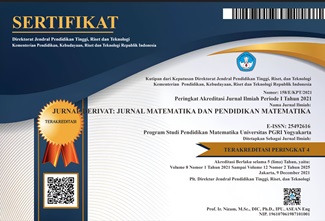Penerapan Model Pembelajaran Kooperatif Picture and Picture untuk Meningkatkan Hasil Belajar Peserta Didik
DOI:
https://doi.org/10.31316/jderivat.v10i1.4681Abstract
Abstract
This study aims to improve science learning outcomes for class VII A students of SMPN 3 Kasihan through the picture and picture cooperative learning model. This is because students are less active in teaching and learning activities as well as low attention to learning material. This type of research is Classroom Action Research (PTK) with the research subject of class VII A students of SMPN 3 Kasihan for the 2018/2019 academic year, a total of 32 students. The implementation of the action was carried out in 2 cycles, each cycle consisting of 2 meetings. The instruments used are observation, documentation, and test. Observation is used to observe during the teaching and learning process, documentation to collect data and student test results, as well as test methods that are carried out at the end of each cycle which are useful for knowing the increase in student learning outcomes. The data analysis technique is in the form of descriptive qualitative. This study showed an increase in student learning outcomes KI 3 (knowledge) cycle I obtained a completeness level of 37.50%, cycle 2 increased to 100%, which means there was a significant increase of 62.50%. Whereas in KI 4 (skills) in cycle 1 the level of completeness reached 59.38% while in cycle 2 it was 90.62% which means there was a significant increase of 31.24%.
Keywords: Learning Outcomes, Picture and Picture.
References
Agus Suprijono. 2011. Model-Model Pembelajaran. Jakarta: Gramedia Pustaka Jaya
A.M, Sardiman. 2007. Interaksi dan Motivasi Belajar Mengajar. Jakarta: PT. Raja Grafindo Persada
Aqib, Zaenal. 2014. Model-model Pembelajaran. Jakarta :Yrama Widya.
Arikunto, Suharsimi. 2012. Prosedur Penelitian. Jakarta: Rineka Cipta
Daryanto. 2011. Penelitian Tindakan Kelas dan Penelitian Tindakan Sekolah: Beserta Contoh-contohnya, Yogyakarta: Gava Media.
Departemen Pendidikan Nasional Republik Indonesia. 2003. UU No.20 tahun 2003 Tentang Sistem Pendidikan Nasional, Jakarta: Depdiknas
Fauzi, R., Dwiastuti, S., dan Harlita. 2011. Penerapan Metode Pembelajaran Picture and Picture Untuk Meningkatkan Motivasi Belajar Biologi Siswa Kelas VIII D SMP Negeri 14 Surakarta Tahun Pelajaran 2011/2012. Jurnal Pendidikan Biologi. 3 (3): 72-78. https://jurnal.uns.ac.id/ bio/article/view/5520/490.
Isman. 2012. Penerapan Picture And Picture Dalam Meningkatkan Hasil Belajar Siswa, Artikel Penelitian. https://media.neliti.com/media/publications/211437-none.pdf
Istarani. 2011. 58 Model Pembelajaran Inovatif (Referensi Guru Dalam Menentukan Model Pembelajaran). Medan: Media Persada
Kuamba, G. Tamboto, Fabiana. dan Supit, Patricia. 2022. Penerapan Model Picture And Picture Untuk Meningkatkan Hasil Belajar Matematika Materi Bangun Datar Pada Siswa Kelas IV SD Katolik 07 Xaverius Kairagi. Jurnal Ilmiah Pendidikan Vol 1 No 7 Juli 2022. https://jurnal.arkainstitute.co.id/index.php/educenter/index
Sadiman, Rahardjo, Haryono dan Rahardjito. 2010. Media Pendidikan: Pengertian dan Pemanfaat-annya. Cetakan ke-14. Jakarta: Rajawali Pers
Ulfa, I dan Aulia, Dita. 2022. Model penerapan picture and picture untuk meningkatkan hasil belajar siswa kelas VIII materi struktur dan jaringan tumbuhan. Jurnal Profesi Keguruan JPK 8 (2), 2022: 168-175. https://journal.unnes.ac.id/nju/index.php/jpk/article/view/33899/13617
Downloads
Published
Issue
Section
Citation Check
License
Copyright (c) 2023 erna fitriani

This work is licensed under a Creative Commons Attribution-ShareAlike 4.0 International License.
Authors who publish with this journal agree to the following terms:
-
Authors retain copyright and grant the journal right of first publication with the work simultaneously licensed under a Creative Commons Attribution-ShareAlike 4.0 International License that allows others to share the work with an acknowledgment of the work's authorship and initial publication in this journal.
- Authors are able to enter into separate, additional contractual arrangements for the non-exclusive distribution of the journal's published version of the work (e.g., post it to an institutional repository or publish it in a book), with an acknowledgment of its initial publication in this journal.
- Authors are permitted and encouraged to post their work online (e.g., in institutional repositories or on their website) prior to and during the submission process, as it can lead to productive exchanges, as well as earlier and greater citation of published work (See The Effect of Open Access).







